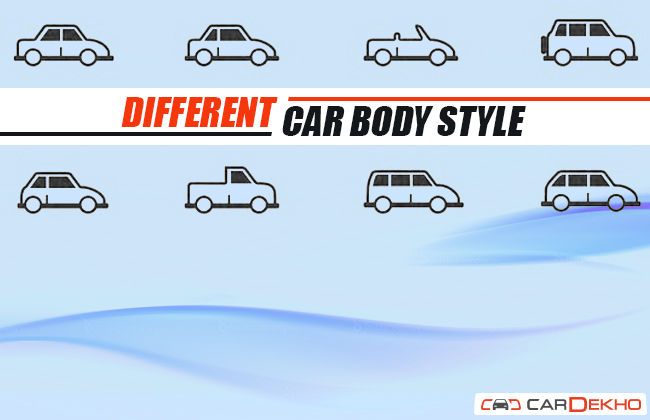Car Design 101 -All you need to know
ಜುಲೈ 16, 2015 11:57 am akshit ಮೂಲಕ ಮಾರ್ಪಡಿಸಲಾಗಿದೆ
- 2.2K Views
- ಕಾಮೆಂಟ್ ಅನ್ನು ಬರೆಯಿರಿ
Do words like hatchback, sedan and SUV sound alien to you? Well, all these and many more such labels refer to a car’s particular body style or the type of design. The current automotive scenario is crowded with several body styles thanks to the marketing teams of carmakers. You dream of a convertible sportscar but family needs come first. Dad prefers a SUV and the kids think that a sedan’s cool. A new type like “MPV” or a "crossover" may further add to the confusion. To scrape you through this confusion so that you don’t end up buying a useless car for yourself , here’s a brief guide on car design types -

Hatchback :

More often than not, the first car one usually buys - is a hatchback. It is relatively easy to maneuver, is sufficiently peppy for the quick dash to the grocery store and is adequate for a humble family of four. Arguably the most sensible as well as the best-selling in passenger car segment, at least in India. Relatively compact car that is best suited for crowded Metros, with heavy traffic and lack of parking space. It comes with a lifting rear door where the boot would be and has decent storage space.
Examples- Maruti Alto, Hyundai i10, Maruti Swift, Honda Jazz.
Sedan/Saloon :

The second most successful form of a car in India is a sedan or saloon. The four-door three-box configuration of a sedan still continues to appeal the buyers who are more comfortable with the conventional body forms. Especially in the executive class, sedan comes as an obvious choice for such customers because of sedan’s plush and balanced overall look.
A sedan seats four or more people and has a fixed roof that is full-height up to the rear window. The roof structure will typically have a fixed B-pillar on sedan models. Most commonly it is a four-door; two-door models are rare, but they do occur (more so historically). Four-door sedans can have either two or three side windows: One in each door (vent windows not counted), and the possible third integrated in the "C"-pillar.
Examples - Volkswagen Vento, Skoda Rapid, Mercedes C Class.
Sports Utility Vehicle (SUV) :

From past few years, love for SUVs in India has multiplied like anything. Originally, these vehicles just had four or all-wheel drive drivetrain that allows all four wheels to receive power from the engine simultaneously and offered a liberty to dodge any terrain. But in recent times the SUV space has grown a lot with varied offerings such as 2WD, soft roaders and compact SUVs, which are not just used for off-roading, but also for regular utilities like any other body form. Early SUVs were descendants from commercial and military vehicles as the World War II Jeep and Land Rover.
Examples - Toyota Fortuner, Mitshubishi Pajero, Tata Safari.
Multi Purpose Vehicle (MPV) :

As the name suggests, this can be used for many purposes. MPV is often a wise choice for a large Indian family that helps in carrying many people along with plenty of luggage. It is as large as an SUV but the off-roading capabilities aren’t really there. Apart from personal usage, MPVs are also very much used in the commercial space as taxis.
Examples - Renault Lodgy, Maruti Ertiga.
Crossover :

This body form is one of the most innovative of the lot. This is a vehicle that is built on a car platform but often with features of an SUV like increased ground clearance and a higher seating position. Crossovers are typically designed only for light off-roading and handling the bad roads without scratching the underbelly.
Example- Hyundai i20 active
Coupe :

The word ‘coupe' comes from the French language in which ‘couper', which means ‘to cut'. And this is what the actual case is. Basically, this vehicle is nothing more than a 2-door stylish avatar of a sedan with a reclining roof line. These are more performance-oriented variants made outright performance.
Examples- Jaguar F Type. BMW M6.
Convertible:

If you think that coupe is not the most practical of cars mentioned over here, then the scenario with convertible is even worse. But the kind of road presence it offers you, is unmatchable. Front two seats dominates the scene, while rear seats are often more cramped than anybody form in this and the boot is inevitably smaller due to the space needed for a folding top.
Examples - Audi A3 Cabriolet, Audi R8 Spyder.
0 out of 0 found this helpful















